![ATOMS: LEGO for the digital generation [Review]](https://img-cdn.tnwcdn.com/image?fit=1280%2C720&url=https%3A%2F%2Fcdn0.tnwcdn.com%2Fwp-content%2Fblogs.dir%2F1%2Ffiles%2F2013%2F12%2FFeat.jpg&signature=c02050c30ea6fd4acc000234307154b2)
With Christmas fast-approaching, you may be starting to sweat (figuratively speaking) over what to get your loved ones. An Xbox One? PS4? Pair of socks? Well, if none of the above take your fancy, there’s always smart building blocks.
Following an uber-successful Kickstarter campaign that saw Seamless Toy Company raise almost 200% of its $100,000 funding goal, it finally launched ATOMS commercially last month.
At this juncture, it’s probably worth noting that Seamless also went on to raise venture capital backing prior to the public launch, which included former Apple executives and U2 frontman Bono. So it’s fair to say there’s high expectations around this company.
Meet ATOMS
ATOMS are essentially a system of plug-and-play sensors, motors and logic blocks, aimed at children and adults alike. Different colors represent different functions – yellow bricks sense things (e.g. detect movement), red bricks ‘connect’ (e.g. power things), green bricks are all about ‘logic’ (e.g. they affect the outputs) and blue bricks are concerned with action – in other words they ‘do’ things.
You can procure individual blocks and construct your own creations, or you can buy starter sets which range in price from $40 to $120. There are four kits at the time of writing.

We managed to get our hands on a Bunsen Set, which is a so-called ‘Scaredy Quark’ that can be afraid of light, and is also prone to being clumsy.
The Bunsen Set ships with a light sensor, control knob, battery, splitter, motor, and audio recorder. While it’s apparently aimed at those aged 6 years and over, based on our initial tinkerings we doubt anyone that young would be able to construct this without a lot of help from an adult or older sibling. That’s not to say it was difficult to build per se, it’s just that it does require paying a lot of attention to the instructions which aren’t always that clear to follow.
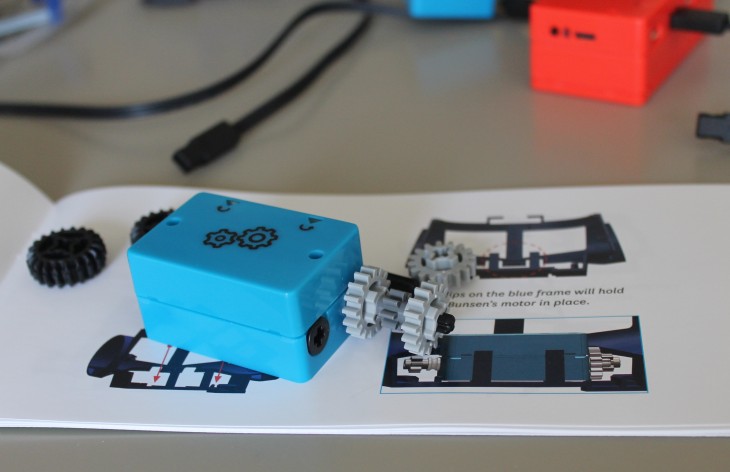
Out of the box you get a lot of individual parts, including blocks, cables, cards…and the shell of a robot that’s broken down into multiple pieces.
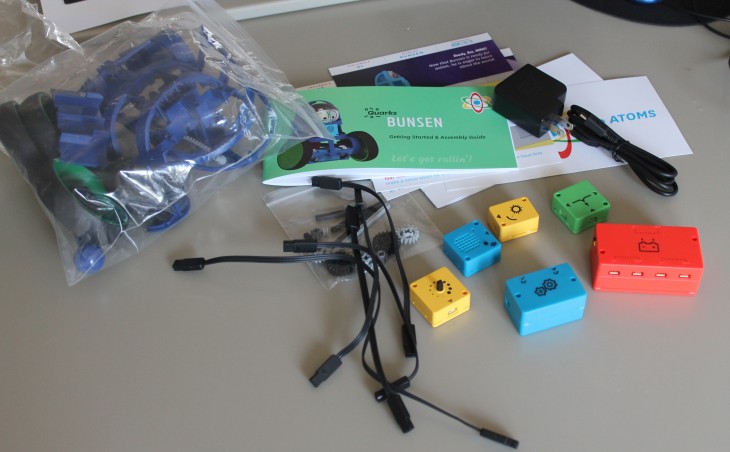
If you’ve ever assembled a flat-pack desk or cabinet, you’ll know that it requires a lot of checking of screws and bolts to ensure the right number of the correct kind are present. Well, with this ATOMS kit, it’s really much the same (though maybe not quite as extreme) and it’s not always clear from the illustrations in the manual what’s what and where it should go. Some of the parts look very similar, which is why photos rather than illustrations would perhaps have helped here.
With a fully-charged (via USB or wall charger) red brick, you can start experimenting by connecting the blocks without actually building the robot. You have to ensure the arrows on the end of the cable and the blocks are facing the same direction, so the outputs are connecting to the inputs on other blocks.
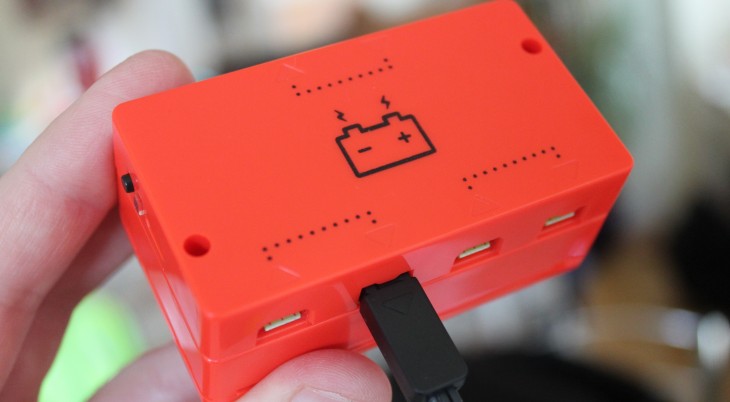
Without the kits, there’s no real application which is why it will be better for many to actually put these blocks into objects such as this little robot, as it helps bring context to something that would otherwise be fairly arbitrary. This is actually a lesson for many technical subjects from programming through to physics – theory is harder to grasp when it’s not put into practice.
It took me about an hour to build the little Scaredy Quark, following the instructions to the very letter.
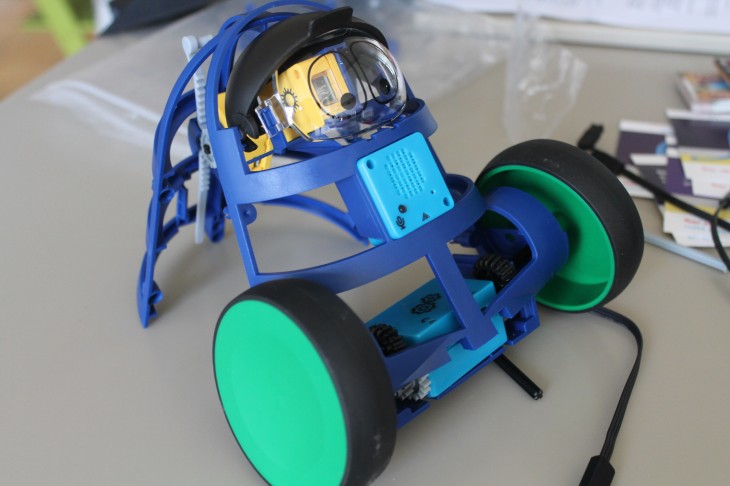
The instructions for building this little fella omit to tell you during the construction process that you won’t be able to connect the wires when it’s assembled.
Indeed, as soon as you reach the ‘You Did It!’ page in the booklet, congratulating you on finishing your work-of-art, it follows this up with a ‘tips’ page for connecting the wires. The first tips include: “Remove the Tail and the Battery“…”Take the two halves of Bunsen apart“…”Slide the Battery out of Bunsen” and more. In other words, you have to undo your good work to actually make this usable.
Yes, it’s a minor grumble, but having fumbled and followed instructions attentively for an hour, it was a little disheartening to read that I would immediately have to pull some of it apart to make it complete. Anyway, that’s what I did.
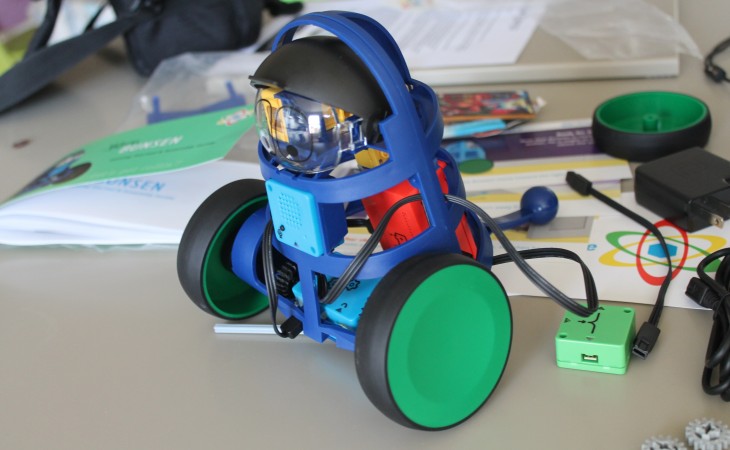
That all said, the ATOMS kit we used was great. The set in itself may not be essential, but it definitely helps you grasp what it is you’re actually doing. For example, the built-in voice recorder means you could record a ‘snoring’ noise which is activated when you pull the visor down over the bot’s eyes. Or you can hide it somewhere (e.g. a dark cupboard) and make it blurt out a noise (“Aaaaggghhhh”) when someone (your mum?) opens the door.
This ties in with the light sensor that comes with the Bunsen Set. It may seem a little bit ‘whatevs‘ without the context of the kit, but when used as a robot’s eyes for example, you can make it move backwards as you shine light into it. Conversely, you can make it move towards the light.
It’s also worth adding here that these have been designed so they can be placed in other kids toys (e.g dolls), sewn into clothing and attached to LEGO blocks. Take the Wave Wand Set, a kit that includes an exploding brick. So you potentially could bring a LEGO house to life by ‘blowing it up’ from the inside, triggered perhaps by the flash of a camera.
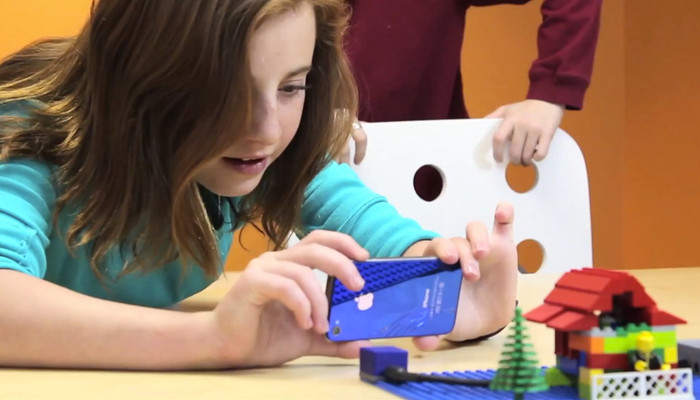
An ATOMS iOS app is also in the works – it’s expected to go live later this month. The Pascal iOS-controlled Robot Kit will actually require this app, connecting via Bluetooth to help you drive the motor, snap photos, measure how much light comes in through the sensor, and more. While Pascal is the primary kit that will use the app, other kits will also be able to tap the app if the creator chooses to include the Bluetooth brick in their specific project.
The only real limitation with ATOMS is the imagination of the builder. Also, as noted already, I’m not entirely convinced these will be of benefit to 6-year-olds without a lot of help from mum and dad, though perhaps I’m doing a massive disservice to the smartness of kids today.
Some of the kits are open for orders now and will ship in time for Christmas, but it’s on a first-come-first-served basis. Meanwhile, if you like the concept behind ATOMS, you may also wish to check out LittleBits, which offers an open source library of electronic modules that mesh together with magnets to help users learn and prototype.
➤ ATOMS
Get the TNW newsletter
Get the most important tech news in your inbox each week.




